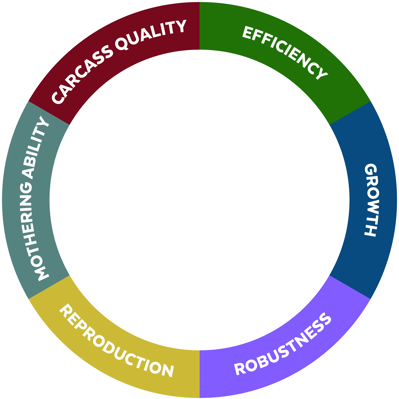Balanced Breeding for Robust and Highly Efficient Pigs
By Danish Genetics - Tuesday, 21 April 2020
The core focus of Danish Genetics is genetic improvement to increase customer profit. This is achieved by our breeding objective which focuses on breeding for robustness, reproduction, mothering ability, efficiency, growth, and carcass quality. We aspire to develop superior genetics of highest value for each actor along the pork value chain.

In this updated breeding program, the aim is to balance selection such that we can secure sustainability in the future animal production landscape, and to achieve that, total farm efficiency (more output for less input) is essential.
Danish Genetics carries out extensive selection and breeding in close collaboration with producers around the world and, in the process, gathers huge volumes of data on a large genetic resource across our three breeds: Danish Landrace, Danish Yorkshire and Danish Duroc. Danish Pig Genetics exploits prolific Danish Landrace and Danish Yorkshire to produce superior crossbred F1 breeding sows with outstanding sustainable economic results.

A balanced breeding program for a more efficient and sustainable production
Balancing the trait improvement emphasis is the key to having a sustainable and animal welfare-friendly system, and Danish Pig Genetics is driving this area by including a diverse set of trait categories in the selection program. Through a focus on mothering ability and robustness combined with growth, feed conversion efficiency, and carcass quality the Danish Genetics breeding animals will deliver more, using fewer resources.
“No trait category can be seen in isolation due to biological complexity of the traits. Therefore, balancing trait improvement emphasis and a wider range of breeding goal traits continue to produce all-round genetic materials with superior productivity and robustness for pork producers globally.” says Dr. Mahmoud Shirali, Senior Geneticist at Danish Genetics.
This means strong, efficient, robust and long-lifespan sows for sow producers, delivering more weaned piglets and therefore more produced meat per sow space for less production cost. The trait improvement package also aims to maximize profit for slaughter pig producers through efficiency, growth, and carcass quality; yielding more lean meat per carcass in a shorter period, for less feed.
A focal point of the new breeding program is more meat produced per sow space per year
Female reproduction is a key driver of farm productivity. Therefore, Danish Genetics utilizes on its famous prolific sows to further improve female reproduction, evaluated using number of live pigs at day 5 after birth. This trait has been shown to be positively genetically correlated to piglet survival and therefore the number of weaned piglets per sow.
Selection for mothering ability leads to sows that yield heavier piglets at weaning that require fewer growing days to finish. This maternal genetic effect of the sow on the daily body weight gain of the piglet from birth to growing period means the Danish Genetics sows produce more meat per space per year.
Robustness to express high production potential
Robustness defines characteristics that ensure that the pig can stay strong and deliver efficient meat and produce more marketed product in different environments. Therefore, robustness has a substantial influence on producers’ profitability.
Improving sow longevity means breeding for sows with a longer productive life, leading to lower replacement costs and more total produced litters per sow. Danish Genetics is focusing on total life cycle efficiency through improved sow survival, increased weaning rate, and higher meat production through growth rate and carcass yield; all while utilizing less feed.
Strength or body conformation of finisher pigs ensures that animals are robust and efficient throughout their productive lifespan. Gilts with high body conformation are expected to have better conformation for insemination, and specially before and after farrowing. To monitor the realization of selection for strength at finishing, the pig’s performance and conformation are monitored throughout their lifespan.
“Broadening breeding objectives to include further traits that better describe productivity and robustness such as daily feed intake, growth, and survival can pave the way for breeding towards health and resilience in the pig breeding programs.” explains Prof. Andrea Wilson of the Roslin Institute.
Growth and efficiency for a more efficient production system
A balanced approach where the maternal traits are emphasized in F1 sows and the terminal line delivers a growthy and efficient slaughter pig performance is essential in an optimized production system for the entire pork production value chain. Danish Pig Genetics is building an optimized balance across feed efficiency, growth, and carcass quality in terminal lines.
We focus on daily body weight gain at different stages of growth. Genetic improvement for daily weight gain from birth to growing period fast-tracks animals and reduces feed costs. Genetic improvement for daily weight gain during the growing-finishing period provides options; either reducing the number of days to slaughter weight or increasing slaughter weight at a fixed slaughter age.
“In an era where reducing the climate impact of pork production is paramount, faster growth for a shorter growing period or indeed higher slaughter weight is hugely important.” Dr. Peter Amer, Consultant at Abacus says, “therefore, improving the efficiency of production of every kilogram of lean meat, across the entire production chain, must take center stage.”
Danish Genetics unique large-scale individual feed intake recording system, set up directly in the Danish Pig Genetics nucleus herds, provides the largest yearly collection of individual feed intake records ever on Danish breeds. This in turn secures a larger and more accurate dataset which will lead to even faster breeding progress for feed efficiency which increases our customers profitability and reduces environmental pollution of pork production.
Accurate measurement leads to improved carcass quality
The value of the carcass drives the income of finisher producers and has substantial effect on the rest of the pork value chain. For slaughter characteristics, we are selecting and breeding directly on backfat and weight the traits that are directly measured and have direct effect on carcass value. Direct selection for backfat utilizes on the known relationships between the backfat measurement with other breeding goal traits, rather than the blackbox approach of lean meat percentage. This ensures that we are providing the necessary emphasis on product quality.
Danish Genetics is committed to providing superior genetic material to the global pig market with exceptional performance and resilience in a range of environments. This is achieved through our extensive breeding program that balances the trait emphasis and diversifies the breeding goal traits.






